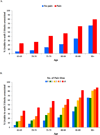Prevalence and impact of pain among older adults in the United States: findings from the 2011 National Health and Aging Trends Study
- PMID: 24287107
- PMCID: PMC3843850
- DOI: 10.1016/j.pain.2013.07.029
Prevalence and impact of pain among older adults in the United States: findings from the 2011 National Health and Aging Trends Study
Abstract
This study sought to determine the prevalence and impact of pain in a nationally representative sample of older adults in the United States. Data from the 2011 National Health and Aging Trends Study were analyzed. In-person interviews were conducted in 7601 adults ages ≥65 years. The response rate was 71.0% and all analyses were weighted to account for the sampling design. The overall prevalence of bothersome pain in the last month was 52.9%, afflicting 18.7 million older adults in the United States. Pain did not vary across age groups (P = 0.21), and this pattern remained unchanged when accounting for cognitive performance, dementia, proxy responses, and residential care living status. Pain prevalence was higher in women and in older adults with obesity, musculoskeletal conditions, and depressive symptoms (P < 0.001). The majority (74.9%) of older adults with pain endorsed multiple sites of pain. Several measures of physical capacity, including grip strength and lower-extremity physical performance, were associated with pain and multisite pain. For example, self-reported inability to walk 3 blocks was 72% higher in participants with than without pain (adjusted prevalence ratio 1.72 [95% confidence interval 1.56-1.90]). Participants with 1, 2, 3, and ≥4 sites of pain had gait speeds that were 0.01, 0.03, 0.05, and 0.08 meters per second slower, respectively, than older adults without pain, adjusting for disease burden and other potential confounders (P < 0.001). In summary, bothersome pain in the last month was reported by half of the older adult population of the United States in 2011 and was strongly associated with decreased physical function.
Keywords: Aging; Geriatric assessment; Locomotor activity; Pain; Prevalence study.
Copyright © 2013 International Association for the Study of Pain. Published by Elsevier B.V. All rights reserved.
Conflict of interest statement
Figures
References
-
- Al Snih S, Markides KS, Ray L, Goodwin JS. Impact of pain on disability among older Mexican Americans. J Gerontol A Biol Sci Med Sci. 2001;56(7):M400–M404. - PubMed
-
- Andersson HI, Ejlertsson G, Leden I, Rosenberg C. Chronic pain in a geographically defined general population: studies of differences in age, gender, social class, and pain localization. Clin J Pain. 1993;9(3):174–182. - PubMed
-
- Bassols A, Bosch F, Campillo M, Canellas M, Banos JE. An epidemiological comparison of pain complaints in the general population of Catalonia (Spain) Pain. 1999;83(1):9–16. - PubMed
-
- Blyth FM, Cumming R, Mitchell P, Wang JJ. Pain and falls in older people. Eur J Pain. 2007;11(5):564–571. - PubMed
-
- Blyth FM, March LM, Brnabic AJ, Jorm LR, Williamson M, Cousins MJ. Chronic pain in Australia: a prevalence study. Pain. 2001;89(2–3):127–134. - PubMed
Publication types
MeSH terms
Grants and funding
LinkOut - more resources
Full Text Sources
Other Literature Sources
Medical



